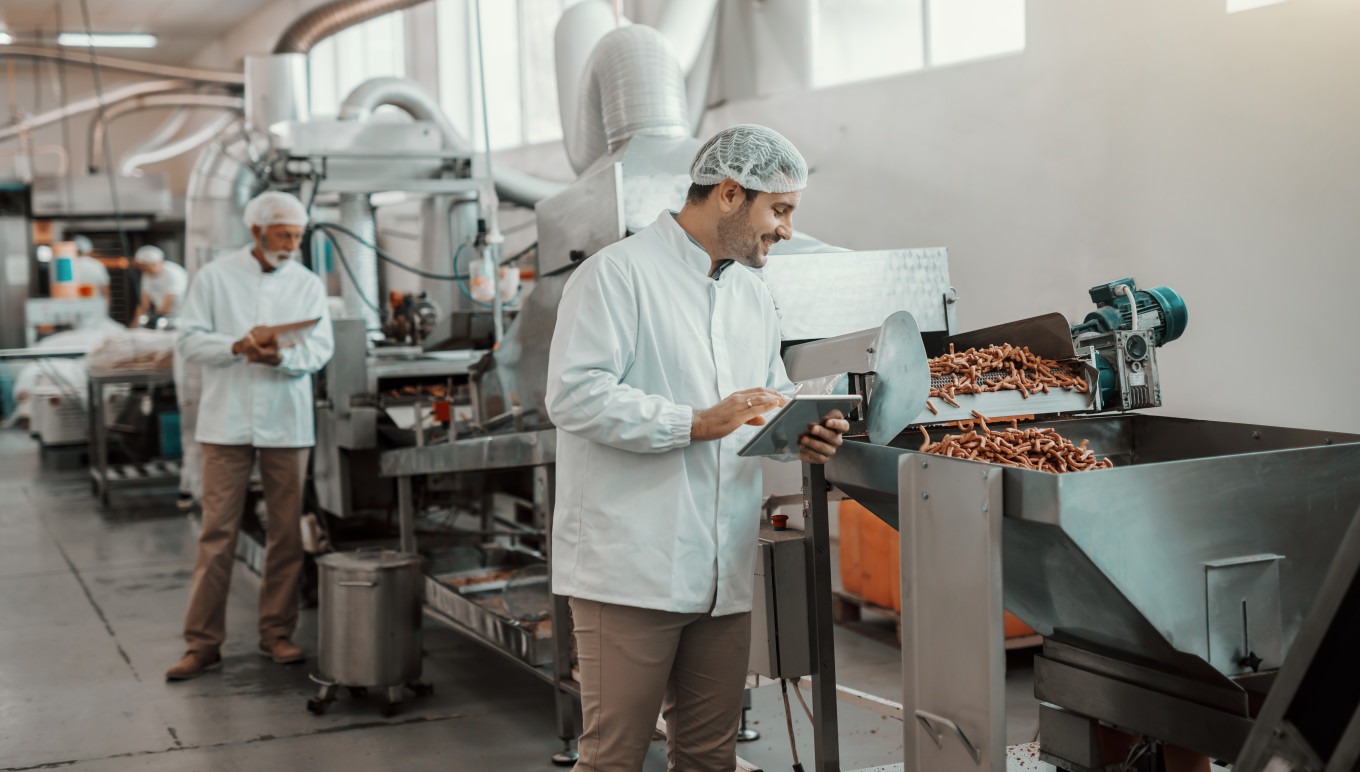Unlocking End-to-End Automation in the Food Industry With Purpose-Built Technology
Unlocking End-to-End Automation in the Food Industry With Purpose-Built Technology
Unlocking End-to-End Automation in the Food Industry With Purpose-Built Technology
Short on Time? Here’s the Gist Automation is redefining how food and beverage businesses operate—driving efficiency, compliance and resilience in a challenging market. From AI in product development to robotics in production, it removes manual work, reduces errors and frees teams to innovate.
This blog explores how automation is transforming every stage of the food and beverage value chain—from sourcing and manufacturing to logistics and maintenance—and shows how purpose-built technology like Aptean’s AI-powered ecosystem can help your business move closer to true end-to-end automation.

Food and beverage businesses aren’t just fighting for efficiency anymore; they’re fighting for survival. That means being ready for regulation, able to pivot with demand and resilient against disruption.
Step into the factories of industry leaders and you’ll already see the shift: robotic arms portioning ingredients, artificial intelligence (AI) forecasting demand and smart sensors monitoring safety around the clock. It’s about staying ahead in a market where labor shortages, rising costs and stricter regulations are testing every operation.
Automation has become the ingredient that elevates your recipe for success. Instead of replacing people, it empowers them—stripping away repetitive tasks, ensuring compliance without hassle and making processes leaner, safer and more sustainable.
But the truth is, many food and beverage businesses I encounter just aren’t operating at that level yet. For most processors, manufacturers and distributors, automation is still a work in progress—rolled out step by step, with the path forward not always crystal clear.
That’s where this blog comes in: I’ll explore how automation is transforming each stage of the food and beverage value chain and highlight practical technologies you can implement now to keep moving toward end-to-end automation in the food industry.
Automation in R&D and NPD
New product development (NPD) and iterating on existing items both present great profit opportunities for food brands, but manual processes often slow down your research and development (R&D) team. Automation helps you get to market faster while reducing errors and admin. Let’s take a look at some examples.
Agentic AI can be used to analyze consumer data and monitor competitor activity, so you can identify new product ideas and opportunities. These insights give you a clearer view of consumer trends, so you can shape recipes around real preferences. AI can also scan recipes, nutritional data and ingredient combinations in minutes to give you options for vegan, gluten-free or healthier alternatives to test.
Then, automated pilot production lines let you test these ideas quickly, cutting the time it takes to launch. Robotics in pilot testing, like automated mixing or portioning for new recipe trials, further facilitate the process. On top of that, product lifecycle management (PLM) systems simplify compliance and product updates by applying ingredient changes automatically across your range, flagging allergens and generating documentation instantly.
For your organization, all of this means quicker product launches, fewer risks and more space for your team to focus on innovation. For instance, Aptean's food and beverage PLM helped manufacturer, Monin, accelerate product innovation by centralizing all formulation, supplier and regulatory data in a single platform accessible globally. This allowed Monin to automate nutritional calculation, customize product specification and generate multilingual labels, while reducing errors—improving collaboration, saving time and speeding up time to market.
Automation in Sourcing and Farming
Sourcing raw ingredients and managing farming operations can be tough with labor shortages, unpredictable weather and strict traceability requirements making the process costly and complex. Automation helps you tackle these challenges with speed and accuracy.
Advancements in robotics, like this novel soft robotic gripper system, allow you to harvest and sort crops faster, reduce waste and lower labor costs—making for more efficient operations and a healthier bottom line. In addition, by automating irrigation and farming techniques, you can ensure your crops get enough water and the nutrients they need to thrive while reducing water consumption and increasing yields. And climate modeling tools use weather data to help you decide when exactly to plant and harvest, so you’re seldom caught off guard by sudden weather changes.
The best part? These technologies can be integrated with your industry-specific enterprise resource planning (ERP) software, helping you drive end-to-end automation and leverage specialized features designed for the food and beverage sector. For example, features such as expiration management and first-expired, first-out (FEFO) analysis help reduce spoilage to ensure everything you source or farm is put to good use, contributing to both sustainability goals and profitability.
A tailored food ERP also offers you real-time visibility of raw material inventories and reliable traceability across the supply chain. This helps you balance supply and demand, so you can avoid shortages and waste. Plus, automatically tracking every item down to the product itself means you’re ready for recalls and can give your customers the transparency they need.
Automation for Procurement and Supply Chain
Anyone running a food business knows how hectic it is to manage a supply chain. Perishable items, fluctuating demand, tight deadlines and multiple suppliers all add pressure. If you’re still tracking your orders manually, waiting for your suppliers’ response or dealing with paperwork, it’s easy for stock to spoil, shelves to run empty or sales to slip through the cracks.
This is where automation in the food industry makes a difference. With a purpose-built food ERP system, you can be alerted to supply-demand gaps in real time and adjust plans to avoid stockouts or overstocking. In addition, AI forecasting tools use historical data and market signals to predict what you actually need, improving purchasing accuracy and cutting waste.
When it comes to working with suppliers, food industry automation again simplifies the process. ERP helps you make better decisions by analyzing suppliers’ track records and certifications. Routine tasks like processing procurement requests are handled through automated systems that can easily compare purchase requests with supplier invoices and delivery receipts to reduce errors.
Even the paperwork gets easier with electronic data interchange (EDI). Purchase orders, invoices and shipping notices are sent automatically, reducing errors while strengthening supplier relationships.
The result for your organization is more reliable deliveries, optimized inventory and smoother supplier collaboration. Take Fresh Connect Central, for example—a produce distributor that transitioned to Aptean’s fresh produce ERP. By eliminating paper-based manual bill of lading handling and automating order management, the business boosted sales volume by about 40%, improved pricing flexibility and freed staff from administrative burdens.
Automation in Production and Manufacturing Processes
As you know well, your production efficiency directly affects your profitability and your ability to meet customer demand. With automation, you can ensure smoother, faster and safer operations by removing delays and reducing manual effort—ensuring orders are fulfilled on time in the most profitable way.
A specialized food ERP equipped with production planning tools helps you stay on track by flagging supply shortages and automatically generating production orders to replenish stock. Smart scheduling tools further reduce downtime by coordinating tasks and adjusting in real time to raw material or equipment limits.
You can rely on robotics to handle repetitive or hazardous jobs like slicing and moving products to cooling racks, improving both safety and consistency. And automated cleaning-in-place (CIP) systems also ensure hygiene and compliance without adding extra labor. Meanwhile, with shop floor production tools and manufacturing execution systems (MES), you get live visibility of production progress, so you can track output and make adjustments without delay.
After implementing Aptean food ERP software, regional pizza chain Pizza Joe’s was able to streamline inventory tracking and production. The system helped remove guesswork and manual processes, thus increasing precision and efficiency.
Automations for Quality Control and Compliance
If you’ve been in food manufacturing for long, you already know how tough it is to balance quality control, compliance, food safety, taste and appeal of your product. Yes, it’s a lot to juggle, but if you have the right system, you can reap the benefits of automation in the food and beverage industry—making it work for you.
Here, a tailored food ERP system again brings effortless automations as standard, digitizing your quality checks, automatically recording results and creating audit trails that make inspections less stressful. It also keeps track of supplier compliance—automating certificate management, sending expiration alerts and reducing the chances of missed requirements.
Meanwhile, a food and beverage PLM makes recipe changes easier, flags allergens in your formulation and generates compliance documents instantly, so your products always meet regulatory requirements. Nutrition and allergen data are also pulled automatically from trusted global sources, reducing the risk of labeling errors.
Internet of things (IoT) sensors add another layer of protection by continuously monitoring conditions such as temperature and humidity. If anything risks product quality or safety, your team is alerted immediately. Moreover, ERP manages responses—automating quality holds, initiating quarantine workflows, logging non-conformance issues and tracking corrective actions. Plus, an ERP system also provides full traceability from raw materials to finished products, giving you the reassurance of being recall-ready at any time.
This means food manufacturers like you can anticipate less manual work, fewer errors and more confidence in your food safety program. Bakery product manufacturer, Baker Boy, leverages Aptean Food & Beverage ERP to enforce food safety standards and manage quality assurance. This automation helped the company achieve certifications like BRC and HACCP by standardizing quality checks and simplifying compliance documentation.
Automation in Inventory and Warehouse Management
Effective inventory and warehouse management is vital for efficiency, compliance and customer satisfaction in the food industry. But manual methods often lead to errors, waste and missed opportunities. That’s where automation steps in.
With a warehouse management system (WMS), your food business gains real-time stock visibility and automated put-away processes that reduce mistakes and maximize space utilization. When integrated with a food ERP, stock data is instantly shared across production, purchasing and sales for complete accuracy.
Aptean Food & Beverage ERP takes this further by automatically monitoring product expiration dates and triggering freshness alerts, helping you cut waste and avoid shortages. Meanwhile, mobile barcode and RFID scanning allow instantaneous data collection, speeding up stock counts and ensuring accurate records.
On the warehouse floor, physical automation in the form of conveyors and palletizers streamlines loading and unloading, reducing manual strain and boosting overall throughput. Fresherized Foods used Aptean Food & Beverage ERP to gain real-time visibility, improve shelf life management and reduce manual errors. The result was higher efficiency, better traceability, faster decision-making and stronger customer satisfaction.
Automation in Maintenance and Asset Management
Downtime and equipment failures can delay order fulfillment and cost food manufacturers big time in customer fines or missed profit opportunities, but thankfully automation helps you keep machinery in top condition without excessive administration.
Enterprise asset management (EAM) systems monitor your equipment and automatically schedule preventive maintenance at the right intervals, reducing the risk of breakdowns. When paired with overall equipment effectiveness (OEE) data, preventive maintenance models detect performance drops early, prompting repairs before a machine failure stops production.
IoT sensors also provide constant monitoring of machine health, tracking factors such as temperature and vibration. If an issue arises, automated alerts notify your team immediately so they can act before it escalates.
Monogram Foods, a Memphis-based food manufacturer, adopted Aptean’s OEE system to improve equipment effectiveness by 10 points through real-time performance management, paperless processes and robust analytic capabilities.
Automations for Sales and Fulfillment
Sales and fulfillment can easily become bogged down in manual tasks—like checking stock, updating records or processing invoices. These small tasks slow everything down, causing delivery delays, order errors, frustrated customers and even hefty chargebacks. By integrating your food ERP software with WMS, you can automate these repetitive tasks. Inventory updates, order tracking and invoice creation happen automatically, reducing admin work and keeping everything consistent.
In the food business, pricing can change frequently with promotions, bulk orders or changes in sourcing costs. Food-specific ERP offers you a pricing matrix tool that automatically applies the right formula to ensure pricing is accurate. Plus, ERP systems with a built-in customer portal let your clients check inventory levels and order statuses themselves.
AI tools add further value by analyzing sales patterns and predicting customers' needs. They can spot when one of your customers is likely to make a purchase, re-order or suggest bundle promotions that boost revenue. Your sales and marketing team can use these insights to plan smarter strategies that improve sales and revenue. Moreover, EDI then automates routine documents like order confirmations, delivery notes and invoices, making communication with customers faster and more reliable.
In short, when automation takes hold, your sales processes become more effective and your team gets more time to focus on building relationships.
Automation in Distribution and Logistics
Getting your products where they need to be—fresh, intact and on time—is critical. A single late or poorly managed delivery can lead to spoiled goods and lost sales. That’s why distribution automation in the food industry is becoming so important. By using automated systems, you can streamline logistics, cut costs and ensure your products arrive in top condition.
A transportation management system (TMS) is a great example of how food industry automation simplifies logistics operations. Instead of manually comparing carriers or costs, the system automates tasks like carrier selection and route consolidation. For larger shipments, AI-driven 3D load planning helps you maximize trailer space and fuel efficiency.
What’s more, with AI-driven route optimization software, your route planning process is turned from a time-consuming manual task to an automated process that takes minutes and produces efficient, cost-effective routes. These time savings mean you can offer later order cut off times while being confident of delivering on customer promises. Implementing IoT sensors in your delivery vehicles can add another layer of protection by autonomously monitoring temperature and humidity during transport to maintain food safety and quality.
When connected to your ERP, both TMS and route optimization tools extend automation all the way to customer communication. Real-time dispatch visibility eliminates the need for manual status updates. Furthermore, electronic proof of delivery (ePOD) tools automatically share updates about deliveries, reducing paperwork and keeping transparency for both customers and internal teams.
The UK’s leading bakery retailer, Greggs, automated route optimization with Aptean routing and scheduling software, improving vehicle utilization by over 30% and cutting nearly 900 miles from weekly routes. This change reduced fuel consumption by over 2% and lowered CO2 emissions by around 35 tons per year, while ensuring timely deliveries and product freshness across 3,500 daily store drops.
Whisking Up Innovation, Efficiency and Growth—The Aptean Way
For food and beverage businesses like yours, the challenge now isn’t deciding if you should automate processes, but instead finding practical ways to expand automation across every stage of your business operations. From product innovation and sourcing to manufacturing, maintenance and distribution, automation powered by industry-specific software, AI and IoT helps you run smoother, faster and safer.
The best automations can be achieved most effectively with a single AI-powered platform connecting all your systems and offering you ready-to-use AI tools for data analysis, demand forecasting and more. Enter Aptean AppCentral.
Our AI-powered ecosystem integrates all your industry-specific apps— including food and beverage ERP, PLM, TMS, EAM and WMS—into a single, secure cloud environment. And provides AI capabilities like natural language queries, agentic workflows, task agents and personalized workspaces straight out of the box.
With AppCentral, automation no longer happens in silos. Your data flows freely across planning, production, quality control and logistics, giving you real-time insights you need to make informed decisions. This means you can scale your operations more confidently—reducing manual work and errors, strengthening compliance and creating the agility to respond to market shifts.
Another quality that sets our software apart is our focus on your industry. Unlike one-size-fits-all providers, we deliver purpose-built solutions for food and beverage, shaped by deep expertise and customer partnerships. That’s why so many food businesses trust us not just as a software vendor, but as a long-term technology partner.
If you’re ready to see how our food industry solutions can transform your operations, the next step is easy: take a free online tour of our food ERP, request a demo or connect with one of my colleagues to discuss your specific needs.
Together, we can help your food and beverage business thrive in a challenging yet opportunity-filled market.
Prêt à transformer votre entreprise ?
Nous avons les solutions ERP spécialisées dont vous avez besoin pour relever les défis de votre secteur.



 Jack Payne | Vice President, Product Management & Solutions Consulting
Jack Payne | Vice President, Product Management & Solutions Consulting